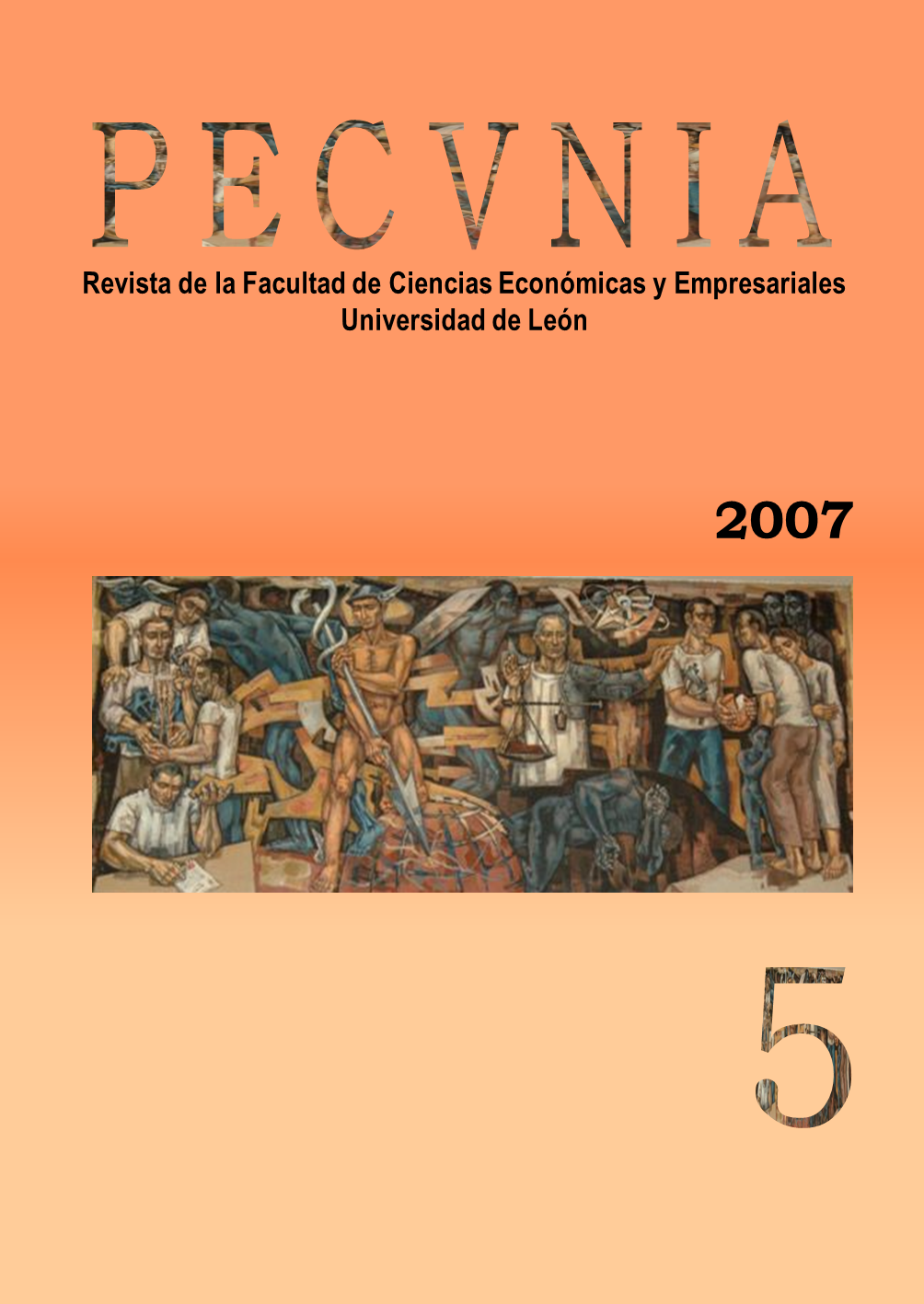Estrategias de internacionalización de la gran banca española
DOI:
https://doi.org/10.18002/pec.v0i5.717Parole chiave:
Banca, Banca española en el extranjero, Internacionalización bancaria, Expansión internacional de la gran banca española, Estrategias de internacionalización, Banking, Spanish banking abroad, International bankingAbstract
La timidez con la que comenzaron a internacionalizarse los bancos españoles, integrantes tanto del actual grupo BBVA como del Santander, aplicando estrategias defensivas y reducidos volúmenes de recursos y riesgos comprometidos, difícilmente hacían presagiar la intensidad y agresividad que ha adquirido en las dos últimas décadas, y que han convertido a dicho proceso en una decisión estratégica de crecimiento para la gran banca española.De forma gradual, tanto el BBVA como el Santander, se han introducido en los principales mercados de Latinoamérica y en los más cercanos e importantes de la Unión Europea. De una implantación generalizada de banca comercial en los noventa, sobre Latinoamérica, se ha pasado a operaciones selectivas en términos operativos y geográficos; llegando a finales de 2007, a liderar diferentes servicios bancarios y parabancarios en la mayor parte de los países del área, con especial incidencia en Brasil, donde el Santander está especializando sus inversiones, y en México, donde el BBVA ha consolidado su implantación y, desde el que se ha servido para iniciar actividades bancarias en el sur de los Estados Unidos. La mayor dimensión internacional del Santander le ha colocado también en posiciones líderes en los mercados ibérico, británico y en el segmento de financiación al consumo en la Europa Comunitaria.The timidity with which they began to internationalize Spanish banks, both members of the current group BBVA and Santander, of applying defensive strategies and reduced volumes of resources and risks involved, hardly did presage the intensity and aggressiveness that has gained in the last two decades, and they have turned the process into a strategic decision to growth for the Spanish banking.Gradually, both BBVA and Santander, has been internalised in the main markets of Latin America and the closest major of the European Union. From a widespread introduction of commercial banking in the nineties, in Latin America, has become selective operations. Actually, in late 2007, these banks lead the banking activities in most countries in the area, special emphasis on Brazil, where Santander is specializing their investments, and in Mexico, where BBVA has consolidated its implementation and, since it had used to start internationalisation in the southern United States. The largest international dimension of Santander has also placed in leadership positions in the Iberian and the British market, and the segment of funding for consumption in the European Community.
Downloads
Riferimenti bibliografici
ALIBER, R.Z. (1976) "Towards a Theory of International Banking", Economic Review, primavera, pp. 5-8.
ALONSO, J.A. (1994) "El proceso de internacionalización de la empresa", Información Comercial Española, Enero 1994, nº 725, pp. 126-143.
BERGES, A.; E. ONTIVEROS y F.J. VALERO (1990) Internacionalización de la banca. El caso español. Madrid: Espasa Calpe. Biblioteca de Economía.
BREALEY, R.A. y E.C. KAPLANIS (1996) "The Determination of Foreign Banking Location", Journal of International Money and Finance, no. 15 (4), pp. 577-597.
CARDONE RIPORTELLA, C. y L. CAZORLA PAPIS (2001) "The Internationalization Process of Spanish Banks in Latin America: A Tale in Two Times", The International Journal of Bank Marketing, Vol. 19 (2-3), pp. 53-67.
CARRASCO CABALLERO, M.C. (2000) "La banca española en Latinoamérica y la evolución reciente de los principales sistemas bancarios latinoamericanos", ICE, nº 783, pp. 51-62.
CASSON, M.C. (1990) "Evolution of Multinational Banks. A Theoretical Perspective", en G. JONES (ed.) Banks as Multinationals. London: Routledge.
CHEVALIER, J.M. (1995) L'Économie Industrielle des Stratégies d'Enterprises. Paris: Edt Montchrestien. Domat Économie.
DUNNING, J.H. (1988) "The Eclectic Paradigm of International Production: A Restatement and Some Possible Extensions", Journal of International Business Studies, Spring, 19, pp. 1-31.
DURÁN HERRERA, J.J. y P. LAMOTHE FERNÁNDEZ (1991) "El proceso de multinacionalización de la banca española", ICE, nº 692, pp. 187-205.
DUSSAUGE, P. y B. GARRETTE (1991) "Las alianzas estratégicas internacionales entre firmas competidoras: Un enfoque inductivo y estadístico", Información Comercial Española, nº 692, Abril, pp. 113-129.
FAULKNER, D. (1995) International Strategic Alliances. Co-operating to Compete. London: McGraw-Hill Book Company.
GOLDBERG, L.G. & A. SAUNDERS (1981) "The Determinants of Foreign Banking Activity in the United States", Journal of Banking and Finance, no. 5, pp. 17-33.
GONZÁLEZ, F. (2002) "Las empresas multinacionales españolas: el caso del BBVA en Latinoamérica", ICE, nº 799, pp. 127-135.
GRAY, J.M. & H.P. GRAY (1981) "The Multinational Bank: A Financial MNC", Journal of Banking and Finance, no. 5, pp. 33-63.
GROSSE, R. & L.G. GOLDBERG (1991) "Foreign Bank Activity in the United Status: An Analisis by Country of Origin", Journal of Banking and Finance, no. 15, pp. 1093-1112.
GRUBEL, H. (1977) "A Theory of Multinacional Banking", Banca Nationale del Lavoro, Quartely Bulletin, diciembre, pp. 349-363.
JOHANSON, J. & J.E. VAHLNE (1977) "The Internationalization Process of the Firm: A Model of Knowledge Development and Increasing Foreign Market Commitments", Journal of International Business Studies, 8 (1), pp. 23-32.
JOHANSON, J. & P. WIEDERSHEIM (1975) "The Internationalization of the Firm-Four Swedish Cases", Journal of Management Studies, October, pp. 305-322.
KIM, T. (1993) "International Banking". en T. Kim (ed.) International Money and Banking. London: Routledge.
MAZA ARROYO, S. (1992) "Análisis de la actividad internacional de la banca española", ICE, nº 704, pp. 66-76.
MAZA ARROYO, S. (1994) "Internacionalización de la banca española. Alianzas y acuerdos de cooperación", ICE, nº 735, pp. 104-117.
OHMAE, K. (1991) El Mundo sin Fronteras: Poder y Estrategia en la Economía Entrelazada. Madrid: McGraw-Hill.
OLIVER, C. (1991) "Strategic Responses to Institutional Process", Academy of Management Review, no. 16, pp. 145-179.
RUESGA, S.M. y J.S. BICHARA (1998) "Inversiones españolas directas en América Latina en los 90", Boletín Económico del ICE, nº 2574, pp. 9-18.
RUGMAN, A.M. (1981) Inside the Multinationals. The Economics of Internal Markets. London: Croom Helm.
SÁNCHEZ PEINADO, E. (2001) "Internacionalización de la banca española: evolución y resultados en los años noventa", ICE, nº 794, pp. 137-162.
SÁNCHEZ PEINADO, E. (2002) "Enfoques de internacionalización en el sector servicios: aplicación al sector bancario español", Revista Europea de Dirección y Economía de la Empresa, vol. 11, nº 1, pp. 67-84.
TERREROS, G. (1999) "Las instituciones financieras y la crisis", Perspectivas del Sistema Financiero, nº 66, pp. 25-43.
VANDERMERWE, S. & M. CHADWICK (1989) "The Internationalization of Services", The Services Industry Journal, January, pp. 79-93.
WIN, Y. & H.V. PERLMUTTER (1977) "On the Identification of Frontier Sings in International Marketing", Columbia Journal of Wold Business, no. 12, pp. 131-139.
YANNOPOULOS, G.N. (1983) "The Growth of Transnational Banking", en M. CASSON (ed.) The Growth of International Business. London: Allen & Unwin.
Downloads
Pubblicato
Come citare
Fascicolo
Sezione
Licenza
Copyright (c) 2007 María del Pilar Sierra Fernández

Questo lavoro è fornito con la licenza Creative Commons Attribuzione - Non commerciale - Condividi allo stesso modo 4.0 Internazionale.
Los autores que publican en esta revista están de acuerdo con los siguientes términos:- Los autores ceden de forma no exclusiva los derechos de explotación (reproducción, distribución, comunicación pública, transformación) a la Universidad de León, por lo que pueden establecer, por separado, acuerdos adicionales para la distribución no exclusiva de la versión de la obra publicada en la revista (por ejemplo, alojarlo en un repositorio institucional o publicarlo en un libro), con un reconocimiento de su publicación inicial en esta revista.
- Este trabajo se encuentra bajo la Creative Commons Attribution-NonCommercial-ShareAlike 4.0 International License. Puede consultarse desde aquí la versión informativa y el texto legal de la licencia.
- Se permite y se anima a los autores a difundir electrónicamente las versiones pre-print (versión antes de ser evaluada) y/o post-print (versión evaluada y aceptada para su publicación) de sus obras antes de su publicación, ya que favorece su circulación y difusión más temprana y con ello un posible aumento en su citación y alcance entre la comunidad académica.












